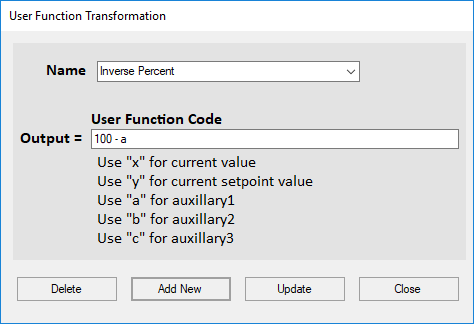User Defined Function Transformation
The user-function transformation takes a floating-point input and converts it into an output based on a function. There are 5 possible variables that can be used to calculate the output. “x” represents the current value, “y” represents the setpoint, “a” represents Aux1, “b” represents Aux2, and “c” represents Aux3.

Example: Finding the percent of Full Load Amps for a machine:
1> Create a calculated tag for Outside Air Damper
2> Forward the value of the % open for the Return Air Damper to Aux1
3> Create a new User Function Transformation
a. Name the transformation “Inverse Percent”
b. In the textbox, type “100 – a”
c. Save the new transformation preset
4> Add this new transformation to your newly created tag as Plugin-1
5> Add a Fixed Color transformation to Plugin-2
NOTE: User defined functions place a greater demand on the system's resources than a predefined equivalent. Therefore, limiting the use of these is advised whenever possible. If a user defined function is required for a large number of tags, it is recommended that a custom transformation be developed for the application.